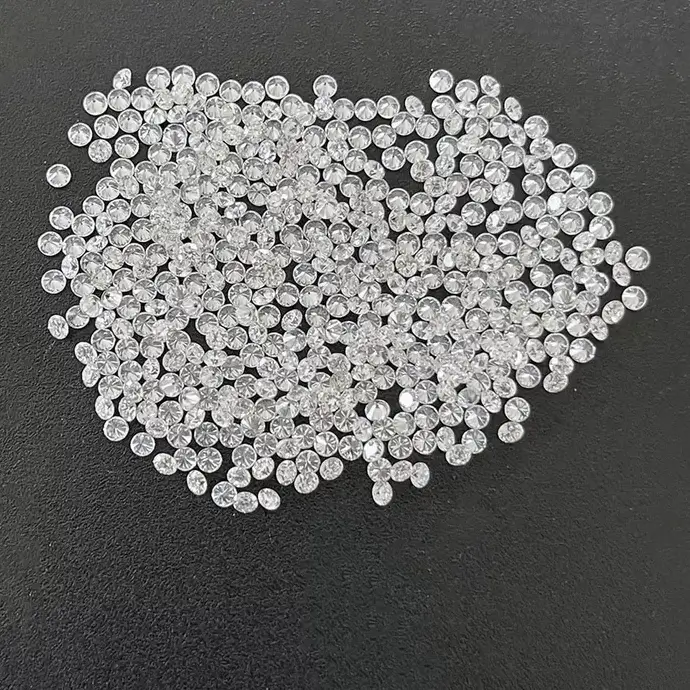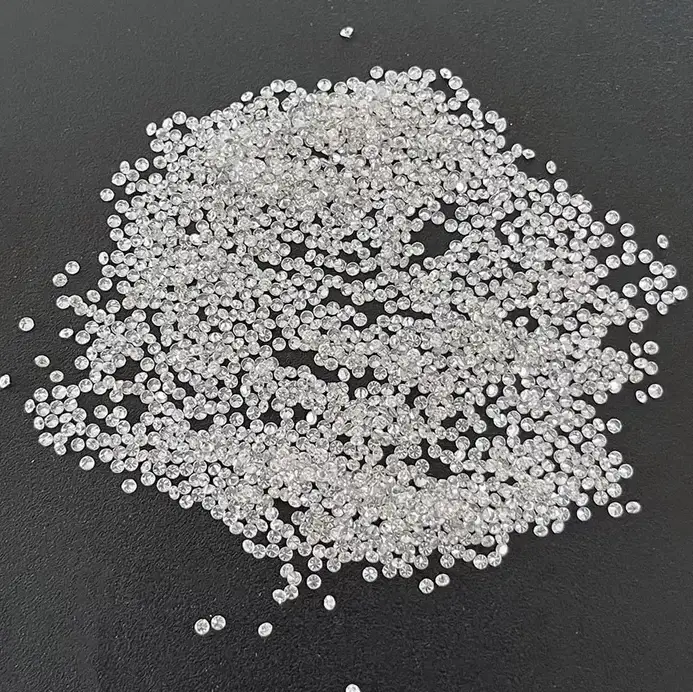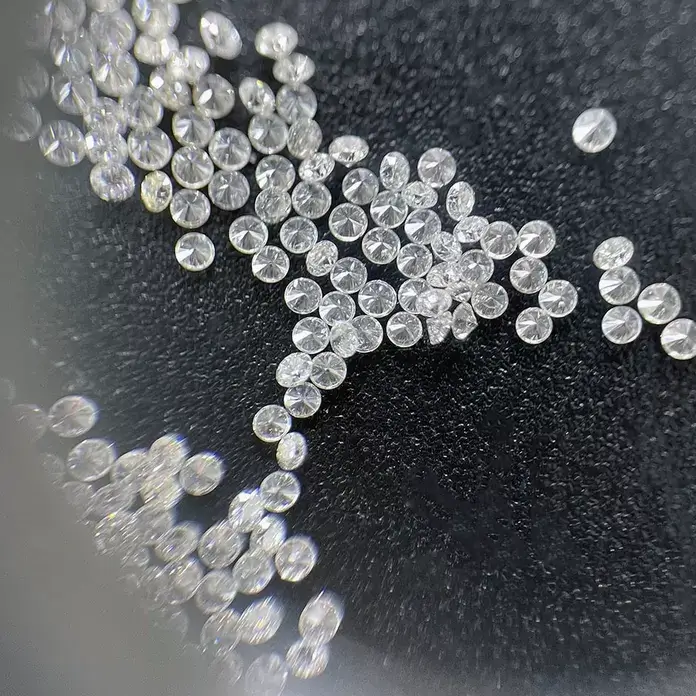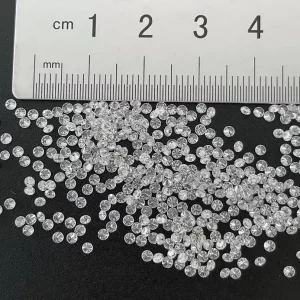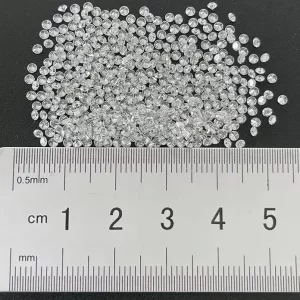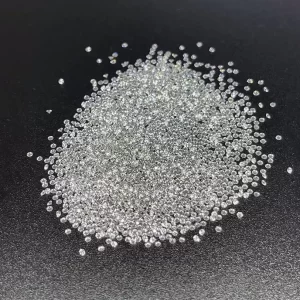0.015ct 0.02ct 0.03ct Melee Excellent Polish Diamond Lab Grown FGH VVS VS SI
FGH VVS VS SI 0.015ct 0.02ct 0.03ct Lab Grown Polished Melee Diamonds For Diamond Jewelry
Lab Grown Polished Melee Diamonds Description
Laboratory-grown diamonds have many different names-laboratory diamonds, laboratory-made diamonds, laboratory synthetic diamonds, and even synthetic diamonds. These names indicate that cultivated diamonds are artificially created in laboratories or factories, rather than naturally formed or mined from the ground. The laboratory cultivating diamonds uses advanced technology to simulate the formation conditions of natural diamonds under the earth’s crust. This formation process is the main factor that distinguishes laboratory diamonds from natural diamonds. The physical and chemical properties of laboratory-grown diamonds and natural diamonds are exactly the same as those of natural diamonds.
Lab grown diamonds is usually produced by chemical vapor deposition (CVD) or high pressure high temperature (HPHT).
Perhaps the oldest way to make diamonds is through a high-pressure, high-temperature process. Since the mid-1950s, laboratory diamonds have become part of the market through this technology.
General Electric first introduced this method, which follows the natural process of diamond creation. It imitates the process of making natural diamonds. It involves using pressure and heat to crystallize carbon deep in the earth.
Laboratory grown diamonds can also come from the CVD process. CVD represents chemical vapor deposition.
CVD diamonds come from various gases, such as methane. They are stored in a vacuum chamber, which decomposes the molecules of the gas, and then these molecules gather on the pre-existing diamond seeds.
What You Need to Know About Melee Diamonds
The size of a melee diamond is small, around 0.001 to 0.2 carats. However, they are not only small in size, but they are also extremely valuable and have an excellent shine for jewelry collectors. Most of the time, these diamonds are used in rings and other accessories. If you are considering purchasing one for yourself, you should read this article! There are some important things you need to know about melee diamonds.
VS clarity
When it comes to diamond quality, you may be looking for a VS clarity or higher. Diamond melees are clear and colorless with perfect symmetry. You can find them in the world’s most expensive jewelry, including diamond engagement rings and stud earrings. This type of diamond is comparable to a grade AAAA diamond and is also used by luxury brands. In addition, this type of diamond is more affordable than a natural diamond.
Besides the cut, another factor in determining the value of a diamond is its clarity. A diamond with VS2 clarity will cost significantly less than a diamond with IF clarity. But diamonds with SI1 clarity are as sparkly as those with VS2 and IF clarity. However, you will want to pay attention to the clarity before buying one. The price will vary depending on the clarity and cut.
Inclusions vary in size and nature and can be crystals, cloudy areas, knots, or small abrasions. Inclusions rarely reach the surface and are therefore not visible to the naked eye. However, large-enough VS diamonds may have a visible inclusion in bright light, but they are eye-clean. The relative size of each inclusion affects its clarity grade. The number of inclusions that can be seen at 10x magnification positively correlates with the clarity grade.
The most common type of melee found in jewelry is the full cut melee. Melees are made in the same fashion as modern round diamonds but are scaled down to smaller sizes. While they look similar, full cut melees differ from single-cut diamonds in sparkle and scintillation patterning. Therefore, it is important to understand these factors before buying a melee engagement ring.
E-F color
The VS clarity and E-F color Laboratory Created Diamond Melee is a beautiful stone at 1/3 of the cost of a genuine diamond. This gem has the same physical characteristics and beauty of a natural diamond. An VS clarity graded diamond will have very few inclusions and show excellent symmetry. An E-F color graded diamond is considered the top colorless grade, and is suitable for white gold jewelry.
The GIA assigns 5 different sub-grades for diamond colors. E-F color is the least expensive, and the GIA assigns grades from D-Z in the following arrangement. A diamond of this color is the perfect addition to any jewelry collection. If you have a limited budget, consider buying one of their inexpensive Melee Excellent Polish Diamonds, but make sure to order in bulk if possible.
Almost 99% of the diamonds used in jewelry today are melees. They are made using the same cutting method as modern round diamonds, but scaled down. The full cut melee is more sparkly, with greater scintillation patterning. Depending on the size and shape of the diamond, you can find one that suits your taste. In addition to this, the cost of a melee diamond may be considerably cheaper than a comparable-sized round diamond.
The GIA’s Tokyo laboratory examined thousands of greenish blue melee diamonds. The color of these diamonds was attributed to a strong GR1 defect, but a thorough analysis by DiamondView revealed that most of them were HPHT and CVD-grown stones. The FTIR and PL spectrums of the CVD samples revealed a double peak at 596/597 nm, a characteristic only seen in as-grown diamonds.
Irradiated laboratory-grown diamonds
Irradiated diamonds are the new standard in lab-grown gemstones. Unlike naturally-formed diamonds, irradiated stones undergo a powerful radioactive treatment to alter their color and clarity. Although irradiated diamonds are safe to wear and exhibit no change in clarity, their intense coloration makes them more difficult to spot than their colorless counterparts.
When it comes to grading, laboratory grown diamonds are characterized by their clarity and color. They are graded VS and E-F. These diamonds are priced at a fraction of the cost of genuine diamonds. VS clarity diamonds feature minimal inclusions and excellent symmetry, while E-F color diamonds are the most colorless of all the color grades.
When buying lab-grown diamonds, always look for a report from a reputable independent lab. While brand names may seem to be a sign of quality, they are not. Not all grown diamonds are created equal, and not all of them are of high quality. A 1-carat lab-grown diamond might sell for $4200 today, while a mined diamond of the same carat weight will be closer to $6000. Although De Beers recently introduced gem-quality lab-grown diamond jewelry at $801 per carat, other growers have kept prices low.
If the Melee Excellent Polish Diamond Lab Grown is not as clean as you would like it to be, you should be wary of purchasing it. Many diamonds may have minor inclusions that are hard to see and will eventually be noticeable to the naked eye. A GHI report will clearly note if the diamond has been treated. The GHI also recommends a VS2 or I grade if it has a visible inclusion.
The color of the Melee Excellent Polish Diamond is due to its strong GR1 defect, and a GIA report from Tokyo revealed this. The results also revealed that most of the diamonds in the study were irradiated natural diamonds and just one HPHT-grown diamond. When comparing IR spectra to PL spectra, the GIA lab found two types of uncommon inclusions: a broad peak at 3123 cm-1 and a doublet peak at 596/597 nm. These are characteristic of as-grown CVD diamonds, and they are also specific to annealing.
Conflict-free diamonds
When looking for a gorgeous new engagement ring, you should consider choosing a conflict-free diamond. Conflict-free diamonds are ethically sourced and have no ties to terrorist groups or war zones. The Kimberley Process has been proven to prevent the trade in conflict diamonds, and many vendors offer this type of jewelry. By choosing a conflict-free vendor, you can feel good about your purchase.
When it comes to purchasing a diamond, you may wonder whether the company’s conflict-free guarantee is worth it. Melee Excellent Polish diamonds come from lab-grown diamond farms that adhere to strict international standards. The company is also committed to ethical and sustainable practices, and works closely with suppliers who are committed to the Kimberley Process. For example, their diamonds come from Canada, Russia, and Australia. The company is also an exclusive online vendor of Canadamark diamonds, which are sourced ethically and responsibly.
0.015ct 0.02ct 0.03ct Melee Excellent Polish Diamond Lab Grown FGH VVS VS SI
